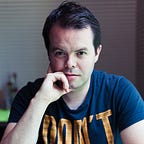Saul Leiter in Five Photographs
Painter-turned-photographer Leiter revolutionised colour photography in the 1950s onwards.
I was looking for new photography-themed coffee table books when I stumbled across the Thames and Hudson ‘Photofile’ series. I didn't recognise many of the photographers they had books about, so I selected a few at random since they were so cheap, and waited for Amazon to send them over.
I'm glad I did. One of the first to arrive was a retrospective of Saul Leiter’s work, the most recognisable of which he produced in the 1950s. He’s still taking photographs today, but it is this period that we can definitely say was his golden era.
Leiter’s photographs are unlike anything else I had ever seen. His images use blocks of colours and disorientating reflections, and exhibit a sensitive appreciation of the details attached to city life. Each frame shows the world as it does not appear in life — it is Leiter’s lens that admits us to this other reality. In the on-going debate about whether photography deserves to be considered art, Leiter’s work is the first thing I turn to in photography’s defence.
1. Black And White, 1949
Saul Leiter was originally a painter, but he is more rightly celebrated as a photographer. He pioneered the use of colour photography, using it from the late 1940s onwards. He was also a creature of the streets, as you can see in this example. Clearly, judging from the motion blur in the shot, he was following these two ladies as he took this photo, but what is, for me, even more interesting is to consider how long it took to get this photo. How long did he have to pound the pavements searching for a couple that matched so perfectly, the black of one’s skirt contrasting with the white of the other’s, the black of one’s cardigan with the white of the other’s? Notice, too, the subtle hint of colour in the stockings — just to prove that the capture is authentic, and not just a black and white short-cut.
2. Red Umbrella, 1957
Another shot that looks like it could have been black and white, this is one of many that Leiter took that features an umbrella. Umbrellas were something of a fascination for him. The general desolation of the scene holds your attention with a monotony that is broken only by a small splash of colour. You can, furthermore, appreciate how Leiter has broken the rule of thirds for this photo, placing as he does the umbrella right up in the corner of the frame. It would have been too easy to place it on one of the focal points in the shot — putting it where he has adds a sense of imbalance to the scene that works very effectively. I do wonder, though, if this is the sort of photograph that would later inspire, through the ‘wonders’ of Photoshop, the kind of spot-coloured nightmares that all first-year photography students now produce.
3. Through Boards, 1957
I don’t know if there was any overlap in the careers of Saul Leiter and Mark Rothko. They both operated out of New York, and their work was both shown at MoMA. A year after Leiter took this photograph, Rothko completed his ‘Four Darks in Red’. There must have been something in the water at the time.
4. Harlem, 1960
If Leiter had a favourite colour, then it must have been red. Many of his best shots are infused with this most powerful colour, and this is a prime example. Again, it has much to teach the would-be street photographer: on their own the tie, the truck, ‘Walker’s Gin’, and the ‘Bar’ sign would not have made for much of a photograph, but together, and in this arrangement, they work wonderfully.
It is unusual to see somebody in the frame looking directly at the camera. More typically Leiter’s people were shot from behind, or from a greater distance, or would occupy a smaller percentage of the frame; a subject face-on like this was a rarity, though there is still something delightfully typical of Leiter in the way that the man’s eyes are hidden by the shade cast by his hat.
5. Phone Call, 1957
I have included this photograph for two reasons. For one, no discussion of the work of Saul Leiter would be complete without a look at one of his favourite tropes: reflections. Much of Leiter’s most striking work shows the visual discordance that reflections from windows and other surfaces can create in a composition, although this double-exposure effect is always controlled, as it is here. The photographer is notably absent from the shot; search as I might I can find no trace of him in the reflections of the windows of the cafe. Note too the perfection of the composition; how the wheel of the bus coincides with the man on the phone in a way that obscures neither object, but rather enhances the connection between them; and how there seem to be reflections of reflections in various places in the scene.
The second reason is that, of all Leiter’s work, this is my personal favourite. New York is an amazing city, and I have visited it, but I will never see it like this, and that is too bad for me. It is only through Leiter that I can appreciate the city when it was at its most raw, at its most exhilarating, and at its most colourful.
All images copyright Saul Leiter, courtesy Howard Greenberg Gallery
